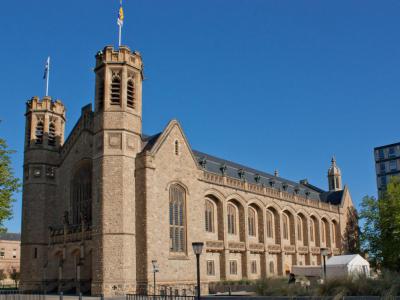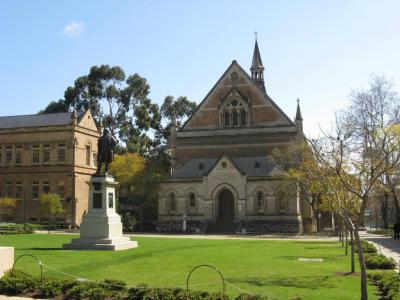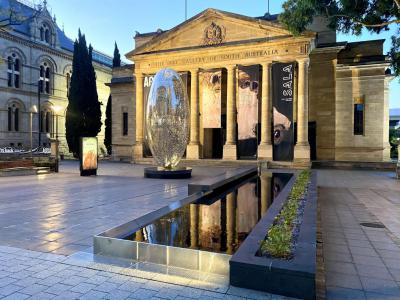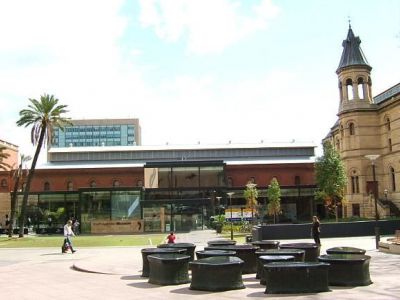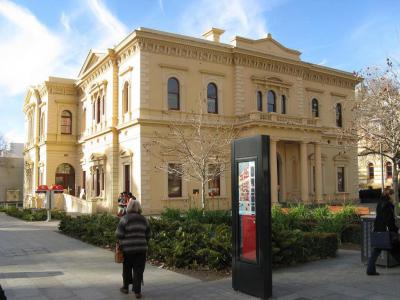University of Adelaide Walking Tour (Self Guided), Adelaide
Established in 1874, the University of Adelaide is the third oldest university in Australia. Its main campus on North Terrace, nestled in the cultural heart of the city, adjacent to the Art Gallery of South Australia, the South Australian Museum and the State Library of South Australia, contains some of Adelaide's most iconic and historically significant buildings.
As the earliest home of the University, North Terrace offers insight into the unique history of UofA. The moment you step in through the campus gates, you can see that the rich history here comes hand in hand with architectural elegance.
Bonython Hall (the great hall of the university) is one of the many historic buildings located at the North Terrace campus. Others include the Mitchell Building (the university's very first facility, home to the vice-chancellor's office), Elder Hall (an iconic conservatory of music, named after one of the university's great benefactors, Sir Thomas Elder), and the cathedral-like Reading Room of the Barr Smith Library. Also notable are the Union Buildings, aka Union Building Group, comprising the Lady Symon Building, the George Murray Building, the Cloisters, Union House and the Western Annexe.
Whether you're a history buff or a regular tourist, you'll enjoy the unique atmosphere created by these and other heritage-listed sites all the same. To discover the beautiful main campus of South Australia’s first, and still top, university, take this self-guided walk.
As the earliest home of the University, North Terrace offers insight into the unique history of UofA. The moment you step in through the campus gates, you can see that the rich history here comes hand in hand with architectural elegance.
Bonython Hall (the great hall of the university) is one of the many historic buildings located at the North Terrace campus. Others include the Mitchell Building (the university's very first facility, home to the vice-chancellor's office), Elder Hall (an iconic conservatory of music, named after one of the university's great benefactors, Sir Thomas Elder), and the cathedral-like Reading Room of the Barr Smith Library. Also notable are the Union Buildings, aka Union Building Group, comprising the Lady Symon Building, the George Murray Building, the Cloisters, Union House and the Western Annexe.
Whether you're a history buff or a regular tourist, you'll enjoy the unique atmosphere created by these and other heritage-listed sites all the same. To discover the beautiful main campus of South Australia’s first, and still top, university, take this self-guided walk.
How it works: Download the app "GPSmyCity: Walks in 1K+ Cities" from Apple App Store or Google Play Store to your mobile phone or tablet. The app turns your mobile device into a personal tour guide and its built-in GPS navigation functions guide you from one tour stop to next. The app works offline, so no data plan is needed when traveling abroad.
University of Adelaide Walking Tour Map
Guide Name: University of Adelaide Walking Tour
Guide Location: Australia » Adelaide (See other walking tours in Adelaide)
Guide Type: Self-guided Walking Tour (Sightseeing)
# of Attractions: 10
Tour Duration: 1 Hour(s)
Travel Distance: 1.1 Km or 0.7 Miles
Author: Jane
Sight(s) Featured in This Guide:
Guide Location: Australia » Adelaide (See other walking tours in Adelaide)
Guide Type: Self-guided Walking Tour (Sightseeing)
# of Attractions: 10
Tour Duration: 1 Hour(s)
Travel Distance: 1.1 Km or 0.7 Miles
Author: Jane
Sight(s) Featured in This Guide:
- Bonython Hall
- Adelaide Elder Conservatory of Music
- Mitchell Building
- Walter Hughes Statue
- South Australia Art Gallery
- South Australian Museum
- Adelaide State Library
- Migration Museum
- Union Building Group
- Barr Smith Library
1) Bonython Hall
Bonython Hall is the University of Adelaide's main ceremonial hall. It was constructed in 1936 from a design by architect Woods Bagot in the Gothic architectural style. The beautiful and imposing building is used for graduation events, puclic lectures and special ceremonies.
Bonython Hall was made to look as though it had been in place for many years. To acquire this feat, Bagot used Murray Bridge limestone and slate roof that was quarried from Willunga.
The building was named in honor of Sir John Langdon Bonython who donated the funds to construct the building. Bonython was a member of the Australian Parliament and a well-known journalist and editor. It is said that Bonython donated the funds on the condition that it be built opposite Pulteney Street in order to prevent a thoroughfare from being built that might divide the university campus.
It is also rumored that Bonython required the building be constructed with a sloping floor in order to avoid any dancing. The Bonython family were very conservative and did not want the building used as a dance hall.
Bonython Hall was made to look as though it had been in place for many years. To acquire this feat, Bagot used Murray Bridge limestone and slate roof that was quarried from Willunga.
The building was named in honor of Sir John Langdon Bonython who donated the funds to construct the building. Bonython was a member of the Australian Parliament and a well-known journalist and editor. It is said that Bonython donated the funds on the condition that it be built opposite Pulteney Street in order to prevent a thoroughfare from being built that might divide the university campus.
It is also rumored that Bonython required the building be constructed with a sloping floor in order to avoid any dancing. The Bonython family were very conservative and did not want the building used as a dance hall.
2) Adelaide Elder Conservatory of Music
The Elder Conservatorium of Music, often referred to as "The Con," is Australia's most senior academy of music, located in the heart of Adelaide. Established in 1883 with a philanthropic gift from Sir Thomas Elder, the Conservatorium is one of the oldest music institutions in the Southern Hemisphere. It has played a crucial role in the development and nurturing of South Australia's rich musical culture.
As a cornerstone of the University of Adelaide, the Elder Conservatorium has grown in prestige and scope over the years, evolving into a 21st-century music training institution of national significance. It offers a wide-ranging curriculum that covers various musical disciplines, including classical and jazz performance, composition, musicology, ethnomusicology, music education, and music technology. The Conservatorium is also known for its focus on diverse musical genres, from classical and jazz to popular and Aboriginal music, and more recently, Music Theatre.
Under the leadership of Professor Anna Goldsworthy, the Conservatorium remains committed to excellence in music education and performance, contributing significantly to Australia's musical landscape. The Elder Music Library, the largest of its kind in the Southern Hemisphere, supports this mission with an extensive collection of nearly 30,000 books, over 120,000 music scores, and around 22,000 sound recordings, making it an invaluable resource for students, educators, and researchers alike.
With a history rooted in tradition and a forward-looking approach to music education, the Elder Conservatorium continues to be a vital institution in Australia’s cultural and educational spheres, shaping the future of music in South Australia and beyond.
As a cornerstone of the University of Adelaide, the Elder Conservatorium has grown in prestige and scope over the years, evolving into a 21st-century music training institution of national significance. It offers a wide-ranging curriculum that covers various musical disciplines, including classical and jazz performance, composition, musicology, ethnomusicology, music education, and music technology. The Conservatorium is also known for its focus on diverse musical genres, from classical and jazz to popular and Aboriginal music, and more recently, Music Theatre.
Under the leadership of Professor Anna Goldsworthy, the Conservatorium remains committed to excellence in music education and performance, contributing significantly to Australia's musical landscape. The Elder Music Library, the largest of its kind in the Southern Hemisphere, supports this mission with an extensive collection of nearly 30,000 books, over 120,000 music scores, and around 22,000 sound recordings, making it an invaluable resource for students, educators, and researchers alike.
With a history rooted in tradition and a forward-looking approach to music education, the Elder Conservatorium continues to be a vital institution in Australia’s cultural and educational spheres, shaping the future of music in South Australia and beyond.
3) Mitchell Building
The very first facility of South Australia’s very first university – the Mitchell Building of The University of Adelaide (established 1874) – was meant to be designed by James MacGeorge, who won the architectural competition for it in 1877. However, the ultimate selection of the architect proved somewhat scandalous, as MacGeorge was replaced by Melbourne-based Michael Egan, who was then replaced by William McMinn and Edward John Woods. While McMinn is largely credited for the project, much of its design apparently was based on Egan’s work.
The foundation stone of the building was laid on 30 July 1879 by Governor Sir William Jervois. Two years later the edifice accommodated first classes, while still under construction. It was finally completed in 1882 and was praised for its Gothic design, described by The South Australian Weekly Chronicle as “thoroughly academic”.
This building housed all of the University of Adelaide’s faculties and activities until the completion of the Elder Conservatorium in 1900 and the Prince of Wales Building in 1902.
In 1961 it was named in honour of Sir William Mitchell, one of the university’s first philosophy academics, who also served as the university’s vice-chancellor from 1916 to 1942 and its chancellor from 1942 to 1948.
The foundation stone of the building was laid on 30 July 1879 by Governor Sir William Jervois. Two years later the edifice accommodated first classes, while still under construction. It was finally completed in 1882 and was praised for its Gothic design, described by The South Australian Weekly Chronicle as “thoroughly academic”.
This building housed all of the University of Adelaide’s faculties and activities until the completion of the Elder Conservatorium in 1900 and the Prince of Wales Building in 1902.
In 1961 it was named in honour of Sir William Mitchell, one of the university’s first philosophy academics, who also served as the university’s vice-chancellor from 1916 to 1942 and its chancellor from 1942 to 1948.
4) Walter Hughes Statue
The statue of Sir Walter Watson Hughes in Adelaide is a tribute to one of the key founders and first donor of the University of Adelaide. This dark bronze sculpture, created by the renowned sculptor Francis Williamson, who was favored by Queen Victoria, depicts Hughes seated in a relaxed manner in a chair. The statue is prominently positioned on a large pedestal made of Murray Bridge granite, located outside the historic Mitchell Building on the University campus.
Sir Walter Watson Hughes, originally from Scotland and born in 1803, emigrated to South Australia in 1840, where he established himself as a successful businessman, pastoralist, and public benefactor. Before being knighted, Hughes was often called "Captain Hughes," a reference to his earlier career as a master in the merchant navy, where he participated in whaling expeditions in the Arctic.
Hughes is particularly celebrated for his substantial contribution to higher education in South Australia. In 1872, he donated £20,000, a significant sum at the time, to support the establishment of a university in the region. This donation was instrumental in founding the University of Adelaide in 1874, the first university in the state and the third in Australia. Hughes is often referred to as the "father" of the University for his pivotal role in its creation and his endowment of the Chairs of Classics, English Language and Literature, as well as Mental and Moral Philosophy.
The statue, funded by Hughes's nephews, stands as a lasting memorial to his contributions to education and the development of South Australia.
Sir Walter Watson Hughes, originally from Scotland and born in 1803, emigrated to South Australia in 1840, where he established himself as a successful businessman, pastoralist, and public benefactor. Before being knighted, Hughes was often called "Captain Hughes," a reference to his earlier career as a master in the merchant navy, where he participated in whaling expeditions in the Arctic.
Hughes is particularly celebrated for his substantial contribution to higher education in South Australia. In 1872, he donated £20,000, a significant sum at the time, to support the establishment of a university in the region. This donation was instrumental in founding the University of Adelaide in 1874, the first university in the state and the third in Australia. Hughes is often referred to as the "father" of the University for his pivotal role in its creation and his endowment of the Chairs of Classics, English Language and Literature, as well as Mental and Moral Philosophy.
The statue, funded by Hughes's nephews, stands as a lasting memorial to his contributions to education and the development of South Australia.
5) South Australia Art Gallery (must see)
The South Australia Art Gallery is a visual arts museum with over 45,000 works of art. It is the second largest art collection in Australia after the National Gallery of Victoria. The South Australia Art Gallery was established in 1881 with purchased items as well as a number of pieces lent by Queen Victoria and the Prince of Wales.
Though the museum was founded in 1881, the building didn't open until 1900. It was designed by C.E. Owen Smyth in the Classical Revival architectural style. The open Doric portico was added in 1936 when the building was expanded. Other extensions were added in 1962, 1979, 1981 and 1996.
The permanent collection consists of Australian art that includes indigenous and colonial artwork, silverware, furniture and photography. It also holds works by European artists like Goya, Francesco Gaudi, Camille Pissarro, Anthony van Dyck and Thomas Gainsborough.
Sculptures from the likes of Barbara Hepworth and Rodin are also included. As part of its revolving exhibits, the museum hosts the annual Festival of Contemporary Aboriginal and Torres Strait Island Art.
Though the museum was founded in 1881, the building didn't open until 1900. It was designed by C.E. Owen Smyth in the Classical Revival architectural style. The open Doric portico was added in 1936 when the building was expanded. Other extensions were added in 1962, 1979, 1981 and 1996.
The permanent collection consists of Australian art that includes indigenous and colonial artwork, silverware, furniture and photography. It also holds works by European artists like Goya, Francesco Gaudi, Camille Pissarro, Anthony van Dyck and Thomas Gainsborough.
Sculptures from the likes of Barbara Hepworth and Rodin are also included. As part of its revolving exhibits, the museum hosts the annual Festival of Contemporary Aboriginal and Torres Strait Island Art.
6) South Australian Museum (must see)
The South Australian Museum is a natural history museum that was established in 1856. The museum holds an exhibit that has more than 4.5 million objects. It sees more than 1.1 million patrons per year.
The museum has a large number of permanent galleries. Among these are galleries featuring ancient Egypt, Australian Aboriginal cultures, megafauna, opal fossils, South Australian biodiversity and indigenous artefacts. The museum is said to contain the largest number of Aboriginal artefacts in the world with more than 30,000 objects. It also has the largest collection of Erlikilyika carvings in the world.
The Aboriginal art and culture is slated to split from the natural history exhibits in the near future. The new Aboriginal cultural center will be held in the old Royal Adelaide Hospital.
Visitors to the museum will find the exhibits spread across five floors. They will also have access to a cafe, coffee hut and museum shop.
The museum has a large number of permanent galleries. Among these are galleries featuring ancient Egypt, Australian Aboriginal cultures, megafauna, opal fossils, South Australian biodiversity and indigenous artefacts. The museum is said to contain the largest number of Aboriginal artefacts in the world with more than 30,000 objects. It also has the largest collection of Erlikilyika carvings in the world.
The Aboriginal art and culture is slated to split from the natural history exhibits in the near future. The new Aboriginal cultural center will be held in the old Royal Adelaide Hospital.
Visitors to the museum will find the exhibits spread across five floors. They will also have access to a cafe, coffee hut and museum shop.
7) Adelaide State Library
The Adelaide State Library, also known as the State Library of South Australia or the Public Library of South Australia, is the largest public research library in the state. Construction of the building began in 1866 but wasn't completed until 1884. It was designed by the Brown and Thompson architectural firm in a French Renaissance style with a mansard roof.
The interior of the Mortlock Chamber of the library has two galleries. One is supported by masonry columns and the other by cast iron brackets. The interior is also adorned with wrought iron and gold that is lit by natural light by the glass-domed roof. The exterior walls are made from brick and Manoora stone. The Mortlock Wing is often considered one of the world's most beautiful libraries.
The library offers a gallery that has permanent exhibitions both inside and out. This includes the Story Wall, numerous memorials, Ernabella rugs and the Kaurna Greeting Stone.
Visitors may explore the library, including the gallery and the Mortlock Chamber on Monday and Tuesday from 8 AM to 7 PM, Wednesday through Friday from 8 AM to 5 PM or weekends from noon to 5 PM.
The interior of the Mortlock Chamber of the library has two galleries. One is supported by masonry columns and the other by cast iron brackets. The interior is also adorned with wrought iron and gold that is lit by natural light by the glass-domed roof. The exterior walls are made from brick and Manoora stone. The Mortlock Wing is often considered one of the world's most beautiful libraries.
The library offers a gallery that has permanent exhibitions both inside and out. This includes the Story Wall, numerous memorials, Ernabella rugs and the Kaurna Greeting Stone.
Visitors may explore the library, including the gallery and the Mortlock Chamber on Monday and Tuesday from 8 AM to 7 PM, Wednesday through Friday from 8 AM to 5 PM or weekends from noon to 5 PM.
8) Migration Museum
The Migration Museum in Adelaide is a social history museum dedicated to exploring the immigration and settlement history of the state. Operated by the History Trust of South Australia, the museum stands as the oldest institution of its kind in Australia, having opened its doors on November 23, 1986, following its establishment as a state government initiative in 1983.
The museum is located on Kintore Avenue, nestled between the State Library of South Australia, the South Australian Museum, and the University of Adelaide. It occupies a complex of early colonial bluestone buildings, set around a courtyard, that historically served as the city's destitute asylum from 1850 to 1918. Before this, the site was home to the "Native School," where British authorities attempted to educate Aboriginal children as part of their broader colonial agenda.
The Migration Museum's mission is to promote cultural diversity and multiculturalism, which it defines broadly to encompass ethnicity, class, gender, age, and regional identity. Through its permanent and rotating exhibitions, the museum tells the diverse stories of South Australians, focusing on the legacies of migration, colonization, and their impact on both settlers and First Nations peoples, particularly the Kaurna people, who originally inhabited the land.
A key feature of the museum is its Memorial Wall, established in 1992, which acknowledges the various communities that have sought refuge in Australia, allowing migrant and refugee groups to commemorate their histories publicly. Another prominent feature is Settlement Square, which symbolizes the arrival of numerous families and individual settlers to South Australia. The museum also houses a Reconciliation Plaque, recognizing the Kaurna people's connection to the land.
The Migration Museum offers a robust program of activities, including educational initiatives for school groups, public events, and family-friendly activities. Through these efforts, the museum works towards a world free of racism and injustice, celebrating cultural diversity and addressing the complex histories that have shaped contemporary South Australia.
The museum is located on Kintore Avenue, nestled between the State Library of South Australia, the South Australian Museum, and the University of Adelaide. It occupies a complex of early colonial bluestone buildings, set around a courtyard, that historically served as the city's destitute asylum from 1850 to 1918. Before this, the site was home to the "Native School," where British authorities attempted to educate Aboriginal children as part of their broader colonial agenda.
The Migration Museum's mission is to promote cultural diversity and multiculturalism, which it defines broadly to encompass ethnicity, class, gender, age, and regional identity. Through its permanent and rotating exhibitions, the museum tells the diverse stories of South Australians, focusing on the legacies of migration, colonization, and their impact on both settlers and First Nations peoples, particularly the Kaurna people, who originally inhabited the land.
A key feature of the museum is its Memorial Wall, established in 1992, which acknowledges the various communities that have sought refuge in Australia, allowing migrant and refugee groups to commemorate their histories publicly. Another prominent feature is Settlement Square, which symbolizes the arrival of numerous families and individual settlers to South Australia. The museum also houses a Reconciliation Plaque, recognizing the Kaurna people's connection to the land.
The Migration Museum offers a robust program of activities, including educational initiatives for school groups, public events, and family-friendly activities. Through these efforts, the museum works towards a world free of racism and injustice, celebrating cultural diversity and addressing the complex histories that have shaped contemporary South Australia.
9) Union Building Group
The Union Building Group is a complex on the Adelaide University campus that incorporates five buildings, namely: the Lady Symon Building (named after the wife of Sir Josiah Symon), the George Murray Building (named after George John Robert Murray, vice-chancellor and later chancellor of the university), the Western Annexe and the Cloisters (1920s-30s), and the multi-story Union House (1975). In essence, it represents two main phases in which the Adelaide University Union (AUU) was developed to provide services and facilities for students on the campus.
The earlier Georgian-style edifices (the Cloisters, the Lady Symon Building and the George Murray building) were designed by the architects Woods, Bagot, Jory and Laybourne-Smith in 1929 and 1937. Ultimately, they set parameters for the design of Union House, an award-winning development of 1975 by the prominent South Australian partnership of Dickson & Platten, noted for the quality of internal spaces and correlation with the earlier architecture.
The use of timber in large-scale structures and the high level of construction craftsmanship place Union House at the top of the buildings created by Dickson & Platten throughout the 1960s-70s. Union House accommodates practically everything that the AUU provides students, including, among other facilities, the UniBar and the famous Adelaide University Cloisters.
An architectural and cultural landmark of Brutalist style, the Union House (listed in 2002) is set to undergo rejuvenation over the next few years. This implies revamping and relocation of UniBar and the refreshment of the historic Memorial Cloisters (originally built as a monument to the University students who fought in WWI). Stage one of the project was completed in February 2019, seeing the Cloisters redeveloped to create a new and multi-dimensional UniBar and entertainment venue for students, staff and general public.
The earlier Georgian-style edifices (the Cloisters, the Lady Symon Building and the George Murray building) were designed by the architects Woods, Bagot, Jory and Laybourne-Smith in 1929 and 1937. Ultimately, they set parameters for the design of Union House, an award-winning development of 1975 by the prominent South Australian partnership of Dickson & Platten, noted for the quality of internal spaces and correlation with the earlier architecture.
The use of timber in large-scale structures and the high level of construction craftsmanship place Union House at the top of the buildings created by Dickson & Platten throughout the 1960s-70s. Union House accommodates practically everything that the AUU provides students, including, among other facilities, the UniBar and the famous Adelaide University Cloisters.
An architectural and cultural landmark of Brutalist style, the Union House (listed in 2002) is set to undergo rejuvenation over the next few years. This implies revamping and relocation of UniBar and the refreshment of the historic Memorial Cloisters (originally built as a monument to the University students who fought in WWI). Stage one of the project was completed in February 2019, seeing the Cloisters redeveloped to create a new and multi-dimensional UniBar and entertainment venue for students, staff and general public.
10) Barr Smith Library
The Barr Smith Library is the principal library of the University of Adelaide, centrally located on the North Terrace campus. It is named in honor of Robert Barr Smith, a significant benefactor who contributed £9,000 to the purchase of books. His family's generosity continued with an additional £11,000 endowment in 1920, and 1928, his son, Tom Elder Barr Smith, further donated £30,000 towards the construction of the library building.
Designed by the renowned Adelaide architectural firm Woods, Bagot & Laybourne Smith, the library officially opened its doors on March 4, 1932. Over the decades, the original structure has seen several expansions, particularly from the 1950s onwards, with the current entrance being added in 1984.
The Barr Smith Library is a repository for a diverse range of collections. It houses Rare Books and Special Collections, along with University Archives and Recordkeeping. The library boasts extensive holdings in various academic disciplines, including Australian history, politics, literature, English literature, world wars, socialism and fascism, women and gender studies, utopian literature, and food studies. Notable specialist collections include the Music Collection, East Asian Collection, Yaitya Ngutupira, and Recreational Reading.
A highlight of the library is the grand Reading Room on Level 2, known for its large, opulent space, offering an ideal environment for focused study. Additionally, the High Use Collection and various study spaces on Level 3 are accessible 24/7, catering to the needs of students and researchers around the clock.
Designed by the renowned Adelaide architectural firm Woods, Bagot & Laybourne Smith, the library officially opened its doors on March 4, 1932. Over the decades, the original structure has seen several expansions, particularly from the 1950s onwards, with the current entrance being added in 1984.
The Barr Smith Library is a repository for a diverse range of collections. It houses Rare Books and Special Collections, along with University Archives and Recordkeeping. The library boasts extensive holdings in various academic disciplines, including Australian history, politics, literature, English literature, world wars, socialism and fascism, women and gender studies, utopian literature, and food studies. Notable specialist collections include the Music Collection, East Asian Collection, Yaitya Ngutupira, and Recreational Reading.
A highlight of the library is the grand Reading Room on Level 2, known for its large, opulent space, offering an ideal environment for focused study. Additionally, the High Use Collection and various study spaces on Level 3 are accessible 24/7, catering to the needs of students and researchers around the clock.
Walking Tours in Adelaide, Australia
Create Your Own Walk in Adelaide
Creating your own self-guided walk in Adelaide is easy and fun. Choose the city attractions that you want to see and a walk route map will be created just for you. You can even set your hotel as the start point of the walk.
Adelaide's Historical Religious Buildings
Adelaide's religious scene is quite diverse, boasting a wealth of denominations such as Christian (like Catholic, Anglican, Uniting, or Orthodox), Islamic, and others. Quite naturally, over the years this has given rise to a rich tapestry of religious sites, many of which today are considered Australia's heritage.
Among these landmarks is Saint Mary's Catholic Church, an iconic... view more
Tour Duration: 3 Hour(s)
Travel Distance: 6.5 Km or 4 Miles
Among these landmarks is Saint Mary's Catholic Church, an iconic... view more
Tour Duration: 3 Hour(s)
Travel Distance: 6.5 Km or 4 Miles
Adelaide Squares and Monuments Tour
Adelaide is a modern metropolis with spacious squares, both functional and beautiful, providing flexible spaces for the community and accommodating a variety of activities. There is also a multitude of historical monuments and statues found in the central quarters of the city. Wandering along the cultural North Terrace boulevard, you will pass by some of the most striking of them.
Most of these... view more
Tour Duration: 2 Hour(s)
Travel Distance: 3.3 Km or 2.1 Miles
Most of these... view more
Tour Duration: 2 Hour(s)
Travel Distance: 3.3 Km or 2.1 Miles
Adelaide Introduction Walking Tour
Adelaide, Australia is the fifth most popular city in the country. It is also the capital of the state of Southern Australia. It was settled by the British in 1836 and named after Queen Adelaide, wife of King William IV.
The settlement of Adelaide was inspired by the need for a city made for free colonists rather than convicts. Edward Gibbon Wakefield led this plan. Settlers were given... view more
Tour Duration: 2 Hour(s)
Travel Distance: 3.7 Km or 2.3 Miles
The settlement of Adelaide was inspired by the need for a city made for free colonists rather than convicts. Edward Gibbon Wakefield led this plan. Settlers were given... view more
Tour Duration: 2 Hour(s)
Travel Distance: 3.7 Km or 2.3 Miles
The Most Popular Cities
/ view all



